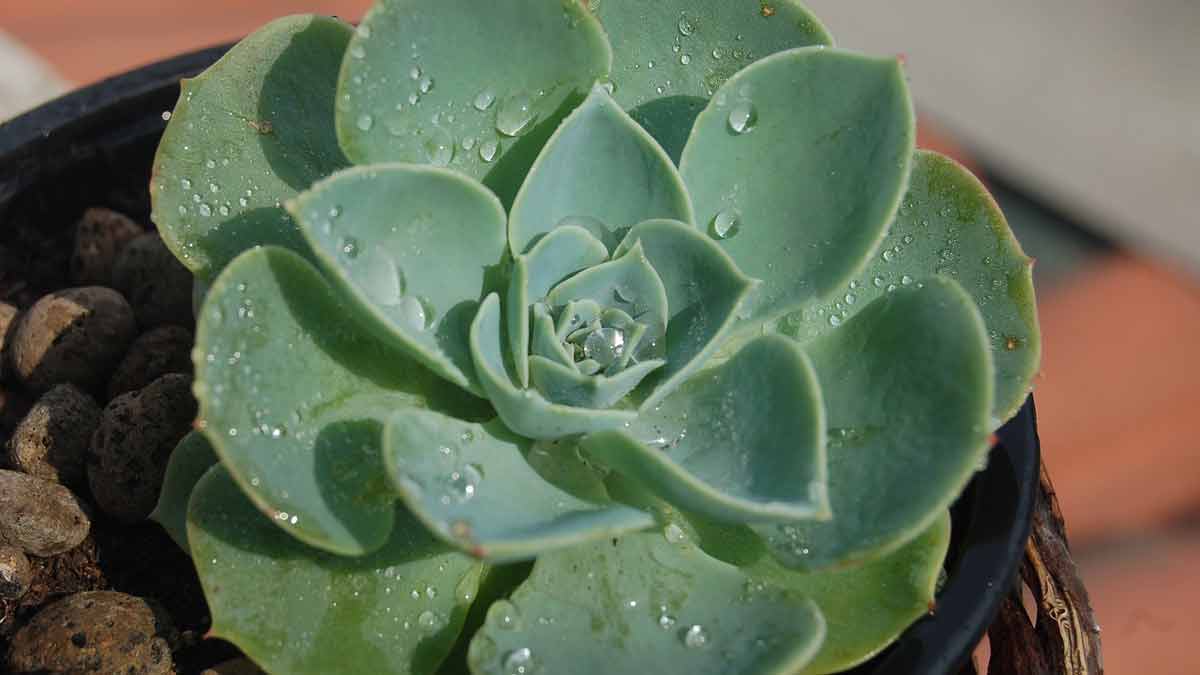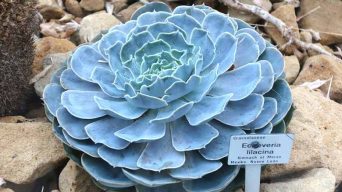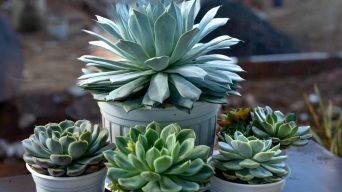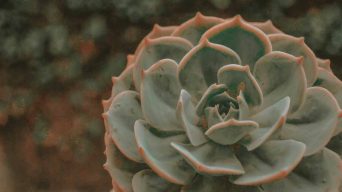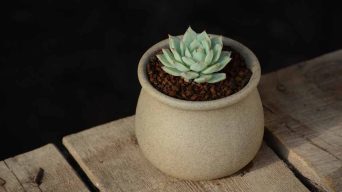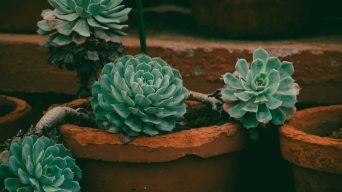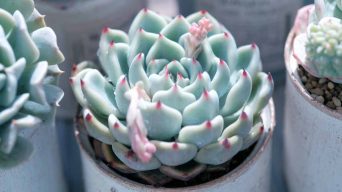Key Takeaways
- Factors affecting Echeveria plants’ watering frequency include temperature, humidity, soil type, drainage, plant size, and age.
- Proper watering techniques involve regularly testing soil moisture and choosing the right method to avoid overwatering or underwatering your plant.
- General guidelines suggest watering Echeveria once every week for ten days while being mindful of seasonal changes and adapting accordingly. Signs of overwatering include rotting roots, foul odor from the soil, and mushy leaves, while parched crinkled leaves are signs of dehydration or underwatering.
Echeveria plants, with their striking rosettes and vibrant colors, are a favorite among succulent lovers.
But how often should you water these captivating beauties to keep them flourishing?
This easy guide will walk you through understanding the factors affecting Echeveria’s watering frequency, such as temperature, humidity, soil type, and seasonal changes.
We’ll provide valuable tips on proper watering techniques to ensure your echeverias thrive in various scenarios while avoiding common issues like overwatering or underwatering.
Factors Affecting Echeveria Plant’s Watering Frequency
The frequency at which Echeveria plants should be watered is affected by various factors such as temperature, humidity, soil type, drainage, plant size, and age.
Temperature And Humidity
Temperature and humidity play a crucial role in determining the watering frequency of your Echeveria plants.
As these succulents are native to semi-desert regions of Central and South America, they thrive in moderate temperatures and low humidity levels.
However, if you live in an area with high humidity or cooler temperatures, you may need to adjust your watering schedule accordingly.
High humidity slows evaporation, meaning your plant will retain moisture for extended periods.
Similarly, lower temperatures result in slower growth rates and reduced water consumption by Echeveria plants.
Soil Type And Drainage
One crucial factor in maintaining the health and happiness of your Echeveria plants is choosing the right soil type and ensuring proper drainage.
Like most succulents, Echeverias prefer a well-draining soil mix that allows excess water to escape easily.
A popular choice for these plants is a mixture of equal parts potting soil, coarse sand or perlite, and peat moss.
Improper drainage can increase the risk of root rot – a common issue among overwatered succulents.
To prevent this problem, it’s vital to use pots with drainage holes that allow excess water to run off instead of pooling at the bottom.
In addition, be sure to elevate your Echeveria plant’s pot slightly above its saucer so that any collected water doesn’t reabsorb into the roots system through capillary action.
Plant Size And Age
A key factor affecting how often to water Echeveria is the size and age of the plant.
Smaller, younger plants generally require more frequent watering than their larger, mature counterparts due to a minor root system and less capacity for water storage in their fleshy leaves.
Over time, as your Echeveria grows and develops more extensive roots and plumper leaves, you’ll notice its thirst decreasing.
It’s crucial to adjust your watering schedule accordingly during this transition period – under-watering can lead to wrinkled foliage or slowed growth; conversely, overwatering can cause root rot, which could prove fatal for your plant.
Seasonal Changes
Seasonal changes play a significant role in determining the watering schedule of echeveria plants.
During the summer months, when temperatures are high, and humidity is low, these succulents require more frequent watering to prevent drying out.
However, when temperatures drop and daylight hours shorten during the winter months, echeverias enter dormancy and can go longer without water.
Regarding seasonal changes, it’s important to adjust your watering frequency accordingly and pay attention to any signs that your plant may be over or underwatered.
For example, during colder months with less light exposure indoors, you should avoid direct sunlight on your Echeveria as they prefer partial shade while still receiving some bright indirect light for proper growth.
How Often To Water Echeveria Plants
To keep your Echeveria plants healthy and to look their best, it is important to water them properly.
This involves understanding general watering guidelines, creating appropriate watering schedules for different situations, and recognizing signs of overwatering or underwatering.
General Guidelines
Watering your Echeveria plants doesn’t have to be complicated.
Here are some general guidelines to follow:
- Water your Echeveria plant once every week for ten days.
- Allow the soil to dry completely before watering again.
- When watering, thoroughly wet the soil all the way through by watering it a couple of times.
- Be mindful of seasonal changes and adjust your watering schedule accordingly.
- Avoid overwatering, as it can lead to root rot and other issues.
- Use well-draining soil and pots with drainage holes to prevent water from accumulating at the bottom.
- Ensure your Echeveria plant is in a location with bright light but not direct sunlight, especially during hot weather.
Watering Schedule For Different Scenarios
Understanding the watering needs of your Echeveria plants in different scenarios is crucial for their overall health and growth.
The table below offers a helpful guide for tailoring your watering schedule to various situations.
| Scenario | Watering Frequency |
|---|---|
| Active growing season (spring and summer) | Every 10-14 days, or when the soil is completely dry |
| Dormant season (fall and winter) | Every 3-4 weeks, or when the soil is completely dry |
| High temperatures and low humidity | Every 1-2 weeks, but be cautious of overwatering |
| Low temperatures and high humidity | Every 3-4 weeks, or when the soil is completely dry |
| Freshly potted or repotted plants | Wait for 5-7 days before watering to allow roots to settle, then follow the regular schedule |
| Plants that are root-bound or have limited soil | Check soil moisture frequently and adjust watering as needed |
Signs Of Overwatering And Underwatering
Overwatering is a common mistake many plant owners make when caring for their echeveria plants.
Signs of overwatering include yellow or wilted leaves, black spots or rot on the base of the plant, and a foul odor from the soil.
Underwatered Echeveria plants will show signs such as thin, wrinkled, and shriveled leaves.
The plumpness of an echeveria’s leaves shows hydration level; healthy ones should be firm and full.
Succulent plants store water in their thick foliage and roots, which means they can tolerate periods without watering, but extended neglect can lead to death by dehydration.
Tips For Proper Watering Techniques
To keep your Echeveria plant in good health, it’s important to follow appropriate watering practices.
This includes checking the soil’s moisture level and using the right watering method.
Testing Soil Moisture
Testing the moisture level in your Echeveria plant’s soil is crucial for proper watering.
To do this, stick your finger about an inch deep into the soil. If it feels dry, then it’s time to water your plant.
However, if it still feels moist, you can wait a few more days before watering again.
Another way to test soil moisture is using a moisture meter tool that can be purchased at most garden centers or online retailers.
These tools are handy and easy to use; they give a quick reading of the soil’s moisture content without the need for guesswork.
Always remember not to overwater your Echeveria plants, as excess water can lead to root rot and other problems that may harm the health of your succulent.
Choosing The Right Watering Method
Selecting the correct watering method is critical for your Echeveria plant’s health.
Consider the following when choosing one:
- Watering Can: Use a small watering can with a spout to avoid getting water on the leaves and stem. Pour the water directly into the soil.
- Spray Bottle: A spray bottle can be used to mist the soil surface lightly, but it should not be used as the primary watering method.
- Soaker Hose: This method works well for large containers or garden beds. Slowly soak the soil until water penetrates several inches deep.
- Drip Irrigation: This automated system helps maintain consistent moisture levels in your Echeveria plants’ soil, avoiding overwatering.
- Bottom Watering: Place your potted plant in a water tray for 30 minutes to absorb moisture from below without wetting its foliage.
Keep in mind that these techniques should be used in moderation and explicitly tailored to echeverias, which are succulent plants that can retain water in their thick leaves and stems and therefore need minimal watering to thrive.
Avoiding Overwatering And Underwatering
One of the biggest mistakes plant owners make is overwatering their Echeveria plants.
This can lead to root rot and other health issues, ultimately resulting in the death of the plant.
On the flip side, underwatering can also harm your plant’s health.
Signs of dehydration include wrinkled or shriveled leaves no longer firm to the touch.
Pay close attention to your Echeveria watering needs to prevent this issue based on its specific environment and size.
Testing soil moisture and choosing an appropriate watering method can also ensure you’re providing enough hydration without going overboard.
Supplemental Watering In Extreme Conditions
Sometimes, extreme conditions can affect how often you need to water your Echeveria plant.
For instance, if the temperature rises above 90°F or drops below freezing point, your plant will require more moisture to survive.
In such cases, it’s best to supplement the natural rainfall with regular watering using a drip irrigation system or a hose with a slow trickle.
Another situation when supplemental watering is necessary is during prolonged droughts.
If there’s no rain for weeks and the soil has dried out completely, you may need to water your Echeveria plants every few days until they recover.
However, ensure not to overwater them, which can lead to root rot and other problems.
To prevent excess water from accumulating in the potting mix or at the bottom of the container, use a well-draining soil mix and ensure drainage holes in the pot.
Final Thoughts
Watering Echeveria plants is not rocket science if you understand the factors influencing their watering frequency.
Following general guidelines and paying attention to signs of overwatering or underwatering can keep your plant healthy and happy.
Remember to test soil moisture regularly, choose the right watering method, and avoid exposing your plant to direct sunlight or soggy soil.

